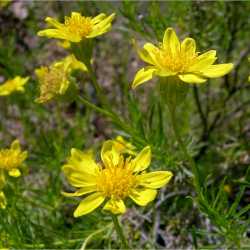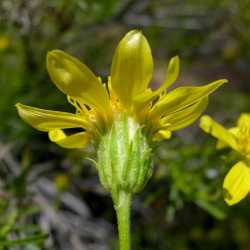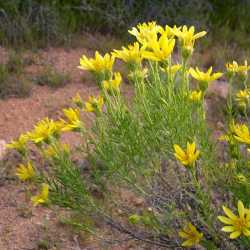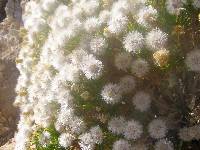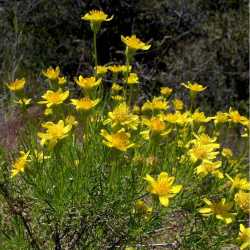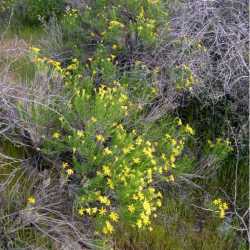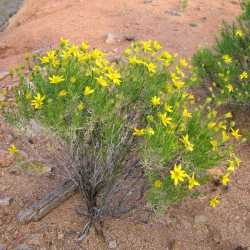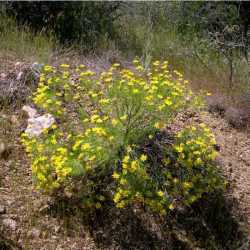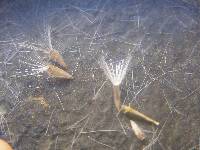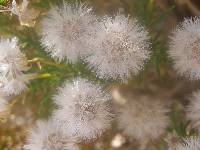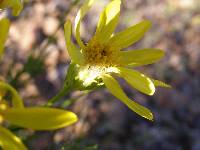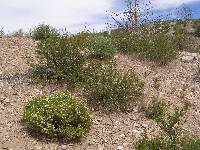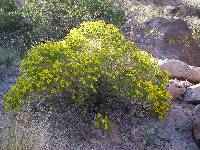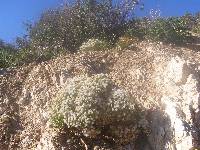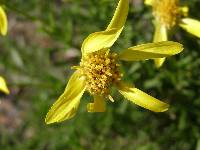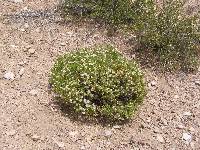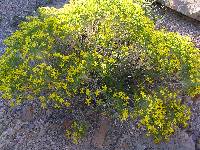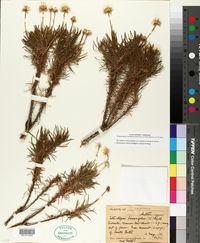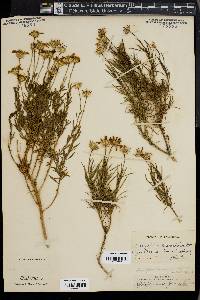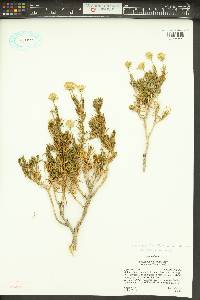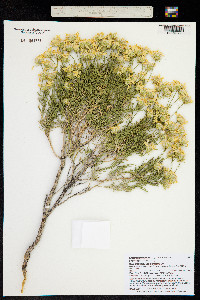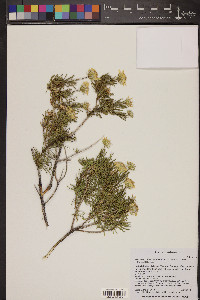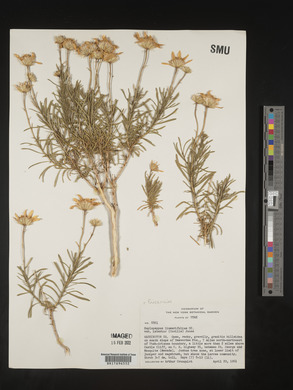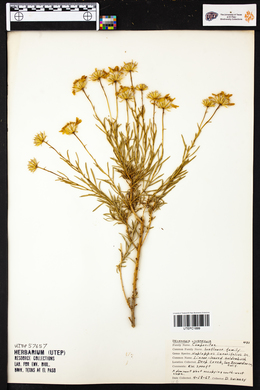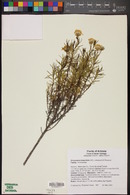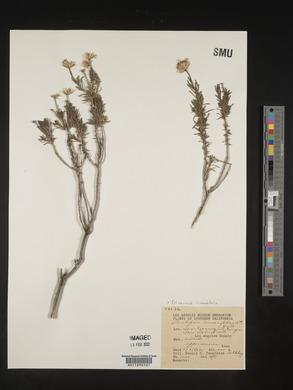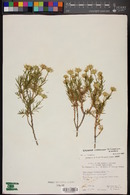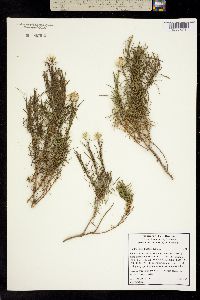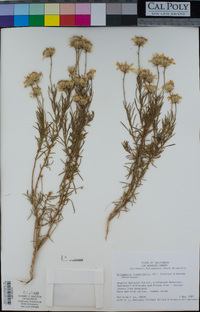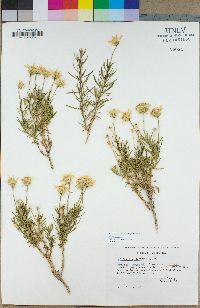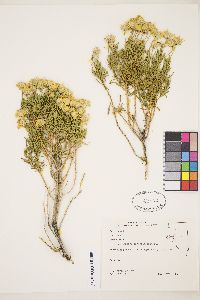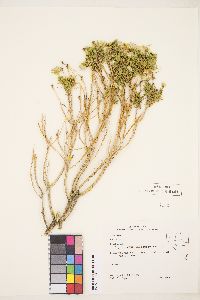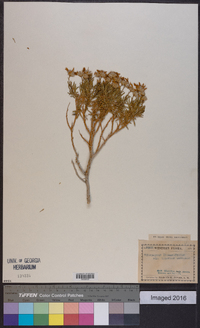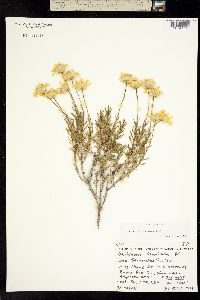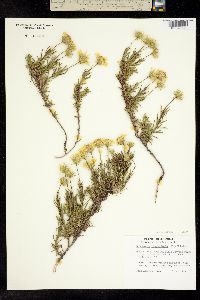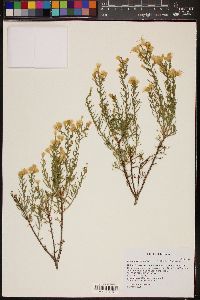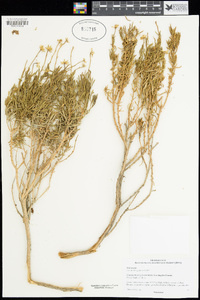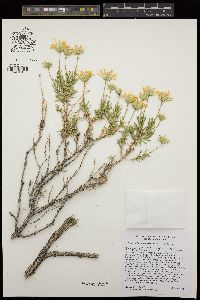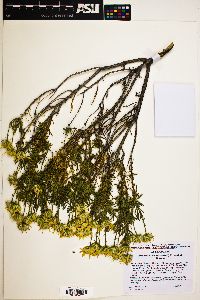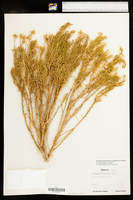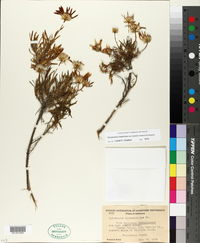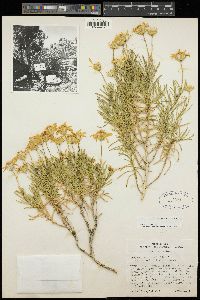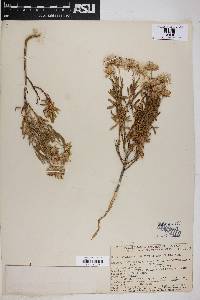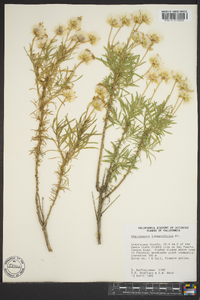
|
|
|
|
Family: Asteraceae
Narrow-Leaf Heath-Goldenrod, more...narrowleaf goldenbush, turpentine bush, narrowleaf goldenweed, slimleaf goldenbush
[Haplopappus interior Coville, moreHaplopappus linearifolius Dc., Haplopappus linearifolius subsp. interior (Coville) Hall, Haplopappus linearifolius var. interior (Coville) M.E. Jones, Stenotopsis interior (Coville) Rydb., Stenotopsis linearifolia (DC.) Rydb., Stenotopsis linearifolia var. interior (Coville) Hall, Stenotopsis linearifolius (DC.) Rydb.] |
Plants 40-150 cm. Stems erect to spreading, green when young, fastigiately branched, glabrous, resinous. Leaves usually ascending or spreading; blades filiform to narrowly oblanceolate (terete or flattened, adaxially sulcate to concave), 12-55 × 0.5-3 mm, midnerves evident, usually not raised, apices acute to acuminate, faces glabrous or sparsely hairy, gland-dotted (in circular, deep pits), resinous; axillary fascicles of 2-15 leaves, shorter than subtending leaves. Heads usually borne singly. Peduncles 20-70 mm (mostly ebracteate). Involucres hemispheric, 8-14 × 8-18 mm. Phyllaries 24-32 in 2-3 series, green to tan, ovate to lanceolate, 4-10 × 0.5-3 mm, subequal, outer sometimes wholly herbaceous, usually mostly chartaceous, sometimes with green, medial stripes, midnerves conspicuous, raised, 1-2 collateral nerves often present, (margins membranous, minutely lacerate to fimbriate) apices acute to acuminate, abaxial faces usually glabrous, sometimes sparsely hairy, often stipitate-glandular, resinous. Ray florets 3-18; laminae elliptic to lanceolate, 7-15 × 2-5 mm. Disc florets 16-60; corollas 6-10 mm. Cypselae tan to brown, narrowly oblanceoloid, somewhat flattened, 4-5 mm (2-ribbed), sericeous to villous; pappi silvery, 5.8-7 mm. 2n = 18. Flowering spring-early summer. Rocky or sandy soils of mountainsides, dry creek beds, deserts, mesas, and interior plains; 70-2000 m; Ariz., Calif., Nev., N.Mex., Tex., Utah. FNA 2006, Kearny and Peebles 1979 Common Name: narrowleaf goldenbush Duration: Perennial Nativity: Native Lifeform: Shrub General: Shrubs, 40-150 cm tall; stems green when young; branches parallel, clustered, and broomlike; glabrous, resinous. Leaves: Alternate and sessile, ascending to spreading, some of the shorter leaves in fascicles; blades linear, 1-5 cm long and up to 3 mm wide, with evident midnerves and acute to acuminate tips, the surfaces punctate-glandular and resinous. Flowers: Flower heads radiate, solitary at branch tips on peduncles 2-7 cm long; involucre (ring of bracts wrapped around flower head) hemispheric, 8-14 mm high, the bracts (phyllaries) 24-32 in 2-3 subequal series, ovate to lanceolate with acute to acuminate tips; outer phyllaries usually mostly tan and papery, sometimes with green medial stripes, the outer surface often stipitate-glandular and resinous; ray florets 3-18, the corolla laminae yellow, elliptic to lanceolate, 7-15 mm long; disc florets 16-60, the corollas yellow, 6-10 mm high. Fruits: Achenes tan to brown, narrowly oblanceoloid, somewhat flattened, 4-5 mm long, sericeous to villous, topped with a pappus of silvery bristles, 6-7 mm long. Ecology: Found on rocky or sandy soils of mountainsides, dry creek beds, deserts, mesas, and interior plains; from 2,000 to 5,000 ft (610-1524 m); flowers spring-early summer. Distribution: AZ, CA, NV, NM, TX, UT Notes: Ericameria is a genus of shrubs with yellow flower heads, mostly broom-like growth form, and seeds (achenes) with tufts of bristles clinging to the tips. E. linearifolia, is rather showy for an Ericameria, with large yellow ray flowers. Look also for the linear leaves with depressed midveins and glands which are visible to the naked eye and even more obvious with a hand lens; and the outer phyllaries which are not very much shorter than the inner phyllaries, and which are often tan and papery with a green midvein. Similar to E. laricifolius, but that species has much smaller flower heads, with involucres 3-5 mm high, the mature heads only about 1 cm wide in fruit, on short peduncles about 1 cm long, (E. linearifolia has involucres about 1 cm high and mature heads 2 cm wide when in fruit, on longer peduncles 2-7 cm long.) Look for this species in Arizona below the Mogollon Rim and on the Arizona Strip, and westward to the southern California coast. Ethnobotany: Unknown, but other species in the genus have uses. Etymology: Erica- refers to heath or broom, and amari means bitter; linearifolia means linear-leaves. Synonyms: Happlopappus linearifolius, Haplopappus linearifolius ssp. interior, Haplopappus linearifolius var. interior Editor: AHazelton 2015 |
|
|
|
This project was made possible in part by the Institute of Museum and Library Services [MG-70-19-0057-19].
Powered by Symbiota


